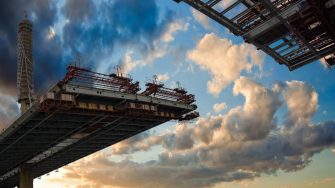
Civil engineers design, construct, manage and maintain the infrastructure of modern society. Roads, railways, tunnels, buildings, bridges, airports, mines, dams, ports and harbours, water supply and sewerage systems and flood mitigation works are all shaped by civil engineers.
Civil engineering is based on Maths, Mechanics and Physics but it’s also about creative problem-solving. While normally associated with the world’s largest buildings, civil engineers must also effectively adapt the infrastructure to complex challenges such as climate change or natural disasters.
Our degrees
Explore our range of civil engineering degrees and get ready to launch your career.
Civil engineering comprises five main areas, which provide a breadth and depth of opportunities for our graduates.
-
Structural engineering underpins and sustains the built environment, ensuring structures are safe, serviceable, durable, aesthetically pleasing and economical.
Structural engineers analyse and design all types of structures, including buildings, bridges, towers, marine structures, dams, tunnels and retaining walls. They’re focused on the materials of construction and their ability to withstand various design loads. Structural engineers apply Maths and Physics to materials such as concrete, stone, steel, timber and glass.
With the world now aware of the challenging implications of climate change and population growth, structural engineers at UNSW are focusing on new and improved low-emission materials and full life cycle assessment of infrastructure including real-time monitoring and recycling of structures.
-
Construction engineering and management, project management and asset management skills are vital to building and maintaining the infrastructure we need to live in modern society.
Construction engineering and project management are about bringing the structural engineer’s designs to life. It involves organising and coordinating the people, equipment, materials and construction processes so that construction work can be done in an efficient, safe, financially viable and environmentally sensitive and sustainable way.
The construction of the Sydney Metro, including train tunnels, bridges and new station caverns in a very congested and active city, is a very good example of the enormous, but rewarding, challenges that project engineers and managers encounter in their careers.
-
The ‘Geo’ component of geotechnical refers to geology, or the ground. Geotechnical engineers are concerned with any structure that is built on, through, or within the ground. They need to understand the engineering behaviour of the natural geological environment to predict how it will respond to imposed loads from engineering infrastructure.
Commencing with educated assessments of the insitu geological conditions, geotechnical engineers work with Geologists to develop geotechnical models of engineering sites. These models evolve with specialist site investigations, laboratory and insitu testing and field monitoring. The geotechnical engineer then uses the model for project design and advice.
Geotechnical engineers deal with many types of infrastructure associated with the ground, including tunnels, bridges, dams, buildings, roads, railways, mines and landfills. They also study landslides and earthquakes, and ways of preventing future landslides from occurring and ways of making infrastructure earthquake resistant.
-
Water engineering looks at how water interacts with all aspects of the built and natural environments. Water engineers investigate the way that dynamic natural systems such as rivers, estuaries and the coasts behave, as well as design infrastructure to store and direct water.
Some of the challenges water engineers address include:
- rainfall and storm prediction modelling taking into account climate change
- water supply needs in different parts of Australia: drinking water, water for industry and agriculture, including wastewater treatment, and water for the natural environment - this may include combinations of dams, groundwater, recycled water and desalinated water
- flood prediction and management: one of the costliest natural disasters for Australia
- groundwater management: water that lies in underground aquifers and deep in the soil
- coastal management: how do we manage the coasts as sea levels rise, how do we effectively protect infrastructure, coastal groundwater resources and estuaries
- rainfall and storm prediction modelling taking into account climate change
-
Transport engineering covers the behaviour, optimisation and management of transport systems. Transport engineers plan, design and operate the large public and private infrastructure systems that connect our physical world. Modern society depends on a broad range of continually evolving, large-scale transport infrastructure, including road, rail, air and water. Transport engineers quantify and optimise our mobility infrastructure networks to meet travel and freight demands, while ensuring safety, equity and sustainability, at minimal levels of congestion and cost.
Transport planning involves developing calibrated mathematical techniques for forecasting travel demand and commuter behaviour. This needs to be based on many challenging variables such as:
- population growth
- changes from petroleum to electrical based power
- share vehicles
- future technological advances
- government emissions policy changes.
Transport engineers face multi-faceted design decisions when they are designing optimised transport infrastructure networks. In all design decisions, multiple performance measures, cost metrics and safety criteria must be considered and weighed. These might relate to:
- the physical expansion of transport facilities, such as lane width or the number of lanes, for a roadway
- the materials and thickness used in pavements
- the geometry of a facility, such as a roadway, rail line or airport
- road pricing schemes
- deploying information-based technology.
Transport operations, whether for road, rail, port or air traffic, are designed to minimise travel delays, improve safety, reduce emissions and enhance reliability, as well as taking other considerations into account. Transport operation decisions may involve optimising traffic signals, setting specific tolls, and designing traffic signs and markings.
- population growth


